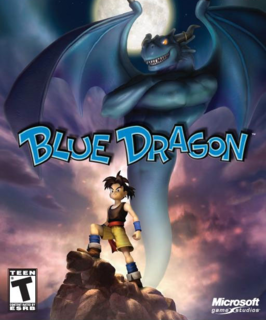Sakaguchi's latest offering is an entertaining, if not revolutionary, roleplaying experience.
Well, you may be disappointed, then. Blue Dragon, for all of its merits, just isn’t that game. It’s not a JRPG evolution. It’s not a storytelling masterpiece. Its not a game that will stay in your memory for years to come, or make you think about events in the wider world. But it is very good fun.
Lets start at the beginning. Blue Dragon follows the story of five young people, mostly children from a small village that comes under attack by a creature called a Land Shark. In trying to stop the creature, Shu, Jiro, and their friend Kluke unwittingly discover that its actually a machine, made by a strange, wizened creature called Nene. The kids soon gain the power of shadow creatures, which take the form of mighty beasts springing from the characters shadows – including the Blue Dragon of the title- which are capable of powerful feats and magic. Realising that Nene is responsible not just for the problems of their village, but of other towns across the world, the heroes set out to put a stop to the villainous wizard. Along the way, the kids from the village meet a strange bat-creature called Marumaro, and a sharp-witted assassin called Zola. They’re not the most original characters the world has ever seen, and nor is the story the strongest you’ve ever taken part in, but all of the characters – even the squeaky-voiced Marumaro- are likeable and appealing, and the game presents itself well enough that you do want to see what happens in the story.
Gameplay follows the traditional style of JRPG’s as well; you have a world map, where you can see little towns and villages represented, field screens, which are the towns, villages and dungeons of the game, and battle sequences where you... y’know... battle. Blue Dragon does distinguish itself at least by representing the enemies that you can fight on both the field screen and world map, and in an interesting mechanic, you can actually choose to fight as many of them at once as you wish, taking on your enemies in sequence. Some enemies also have rivalries with other creatures, and you can get them to fight one another in the games interesting Monster Fight. The battles themselves are a strictly turn-based affair, with a bar across the top of the screen indicating the turn sequence and with magic and attacks straight from a Final Fantasy game- not surprising considering the guy who devised it. Interestingly, you can opt to ‘charge up’ most of your attacks, which makes them more powerful but will affect your place in the turn sequence. This gives an interesting tactical addition- do you cast that healing spell now, and cure a small amount of hit points, or do you charge it up to heal more- but risk a character dying before you can cast it? Your characters don’t actually gain experience themselves, either- instead it’s your character’s Shadows that grow stronger throughout the game. There are various classes that you can switch between to learn their assorted skills, which can then be combined in any way you like for use in battle. This is pretty fun, as you can specialise your characters in some areas but also let them have access to, say, a few White magic spells for healing, a few defence increasing Guardian abilities, and so on. Fortunately, the battles aren’t generally too difficult, so the games not usually a great challenge, and you can safely avoid some of the monster encounters if you wish without fear that the next boss will be too difficult. That said, the game does have its trickier moments, and a couple of the diversionary mini games can be quite challenging.
Visually, the game looks lovely. Character models are well crafted and look great, and the backgrounds are lavish and detailed affairs that have a lot of nice touches. Battle sequences are no exception, with the Shadows looking really great and the spell effects are beautiful. Unfortunately, the framerate often struggles to keep up with what’s going on, but this doesn’t detract too much and is forgiveable when the game has such lush visuals. Sound wise, you’re in for an equal delight. Uematsu’s score lacks the complexity of some of the Final Fantasy soundtracks, but it’s full of hum-along tunes and beats that will stick in your head for quite a while, and stands out as some of his better music work for me, although it has its low moments. The voice acting is generally good, with no performances standing out as particularly good or particularly poor, either. You can have the game in its original Japanese as well, which really helps matters.
Overall, I found Blue Dragon to be a thoroughly entertaining game. Its some of the most fun I’ve had from an RPG for quite some time, and I never felt that getting through the game was a chore. The great presentation doesn’t hurt, although some might be put off by the old-school styling and the underwhelming story. Still, it’s a lengthy experience, clocking in at some 50-60 hours for an average play through, and although it loses its pace a little towards the end it generally stays fun throughout. There’s a good deal of optional content, most of which is marked with some of the games difficult to unlock achievements- don’t expect a couple of hundred gamerscore points just for getting through the game; Blue Dragon will make you work for them. But gamerscore aside, completing Blue Dragon is its own reward, and whilst it might not go down in the annals of the greatest computer roleplaying games, it deserves a place in the hearts of those who are after an entertaining experience.

